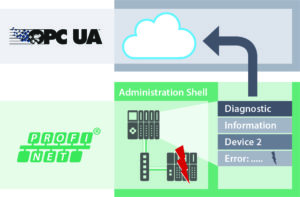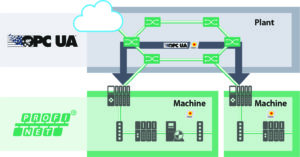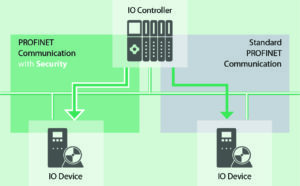Implementing Industry 4.0 concepts requires many components. Only when data can be transported between controllers from different manufacturers – when safety, security, and semantics are considered – have the requirements for networks been met for Industry 4.0. PROFIBUS & PROFINET International (PI) grappled with this early on. Now, they have concrete solutions.

Recently, experts from PI and the OPC Foundation have specified a solution for presenting PROFINET data in the OPC UA object model at a joint working group. PROFINET’s OPC UA companion specification is set to be reviewed soon.
“In the coming years, we want to further intensify our longstanding cooperation with the OPC Foundation – a partnership that has yielded technologies like FDI,” emphasized Karsten Schneider, Chairman of PI. “We can mutually benefit from each other’s expertise, thereby facilitating Industry 4.0 in communication.”
According to an extensive poll of users, the most significant content of PROFINET’s OPC UA companion specification includes the collection and display of asset management and diagnostic data. Asset and diagnostic data from the devices used today can be collected in a system controller through existing PROFINET services and delivered to higher-level entities by means of OPC UA. An edge gateway can also offer this service, which can be used as an additional application on the system. It’s also possible to directly integrate OPC mapping in a PROFINET field device. “In this OPC UA use-case, the basic features of PROFINET are once again proving to pay off – specifically, PROFINET’s openness for parallel TCP/IP communication and its comprehensive structuring of data,” said Schneider. These possibilities also lay the foundation for further applications, such as the implementation of individual OPC UA modeling (e.g. for collecting energy data) or of standardized models (e.g. Namur Open Architecture (NOA)).
Communicate Safely with OPC UA

The use of functionally safe devices has grown rapidly over the past few years. In 2018 alone, the number of PROFIsafe nodes added to the market increased by 2.2 million. Nowadays, over 10 million units have been integrated into production systems. Another trend is the distribution of complex automation tasks to multiple controllers, communicating with one another via OPC UA, for example. If controllers from different manufacturers have to be connected to one another in a functionally safe way, special couplers are required. This usually comes along with high hardware and engineering expenditure, and inflexible handling.
As OPC UA will play an increasingly important role for connections between the controllers of different manufacturers, it made sense to expand the mechanisms of PROFIsafe to OPC UA as well. The experts are defining key parameters for functional safety and boundary conditions. The safety concept is available to all members of the OPC Foundation and PI. It is compliant with IEC61784-3 “Functional safety fieldbuses” and uses existing safety mechanisms. The “Safety over OPC UA based on PROFIsafe” specification, is under review. Test specifications with definitions of the test procedures will also be developed.
Standardized Information
Digital factories’ intelligent manufacturing networks will only become a reality with machine-processed, standardized information, due to the cross-company and cross-industry nature of their work. In the future, more and more information will be passed on to IT systems like MES and in cloud applications and then processed there. “The aim here is to classify the data to be processed beforehand. Our method of singling out known use-cases and developing suitable solutions is also tried and tested here,” said Schneider in describing the method. At the moment, these are applications from predictive maintenance and asset management. “We already have experience with standardized and machine-readable parameters here, such as in determining identifiers for the PA profile and AM data record in cooperation with AIDA.”
OPC UA and eCl@ss are playing an increasingly important role in regard to industrial automation. For OPC UA, PI is working closely together with the OPC Foundation to provide companion specifications with defined information models. Additionally, PI is working with the FieldComm Group on an FDI device information model for process automation with the goal of implementing the NOA architecture requirements in an optimum way. These models will then – in cooperation with eCl@ss e.V. – be expanded by semantic identifiers for device parameters, for example, which have been defined in PI’s specification documents. The plan is to first determine the relevant parameters of PA profile 4.0 and assign semantic identifiers. The results are being documented in a mapping table which both organizations are able to use. These results will be available on the PI website and in the eCl@ss download portal. On the part of eCl@ss e.V., the device parameters being handled in the scope of the cooperation are being incorporated in the eCl@ss product description system as properties and provide the necessary semantic identifiers.
The topic of semantics is essential for the automatic interaction of various different systems and components from different manufacturers. It’s also a requirement so that business processes between end users, suppliers customers, etc. run optimally in systems of the Industry 4.0 generation. “In the future, platforms like Mindsphere and Predix which automatically divert information from a system to different apps for further processing will be used. This only works if the data has been appropriately prepared and standardized.”
Security Strategies

Networking in systems is increasing more and more. The risk of threats such as spoofing is on the rise. It’s only logical to continually reassess automation networks and to develop corresponding security concepts. “In contrast to PI technologies, however, there is no out-of-the-box solution for security which can be carried out like a cooking recipe, so to speak,” reiterated Schneider. The protective mechanisms and concepts cannot interfere with production and have to remain practical and affordable.
PI isn’t able to guarantee overall security in terms of system security. “That’s why, when it comes to security concepts, PI technology is secured using state-of-the-art technology in such a way that it’s made as difficult as possible for the attacker,” said Schneider. One path to this destination is described in a white paper “Security Extensions for PROFINET”. It was developed by PI together with several IT experts and is available for free download on the PI website.
Outlook
These examples represent only a cross-section of the work currently being carried out by PI. The aim is to reduce the complexity of all projects in such a way that the user is not impaired in their day-to-day work. The topic of migration also has to be given some attention. Currently, around 80 million devices with PI technologies are reliably carrying out their work around the globe. They’ll have to continue in the era of Industry 4.0!

Karsten Schneider
Chairman of PROFIBUS & PROFINET International
